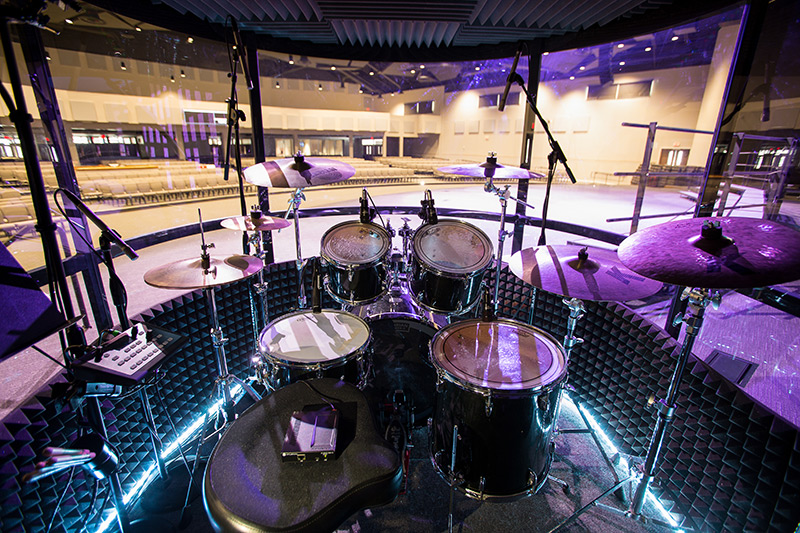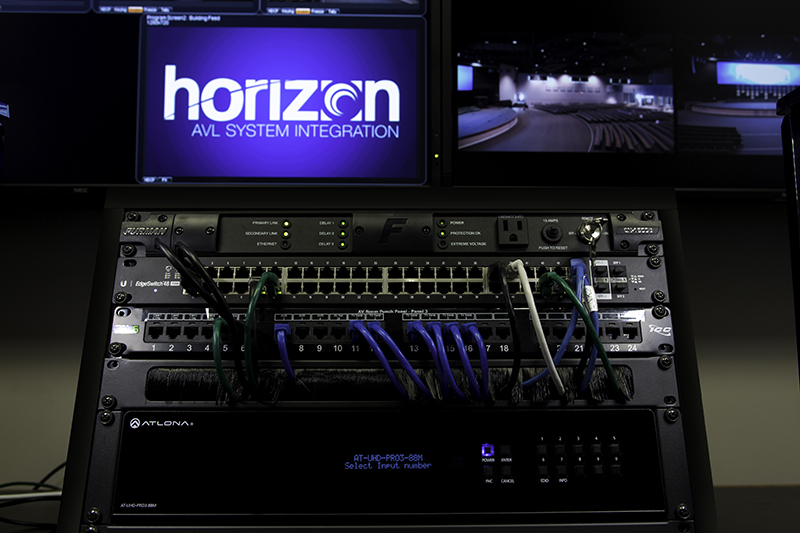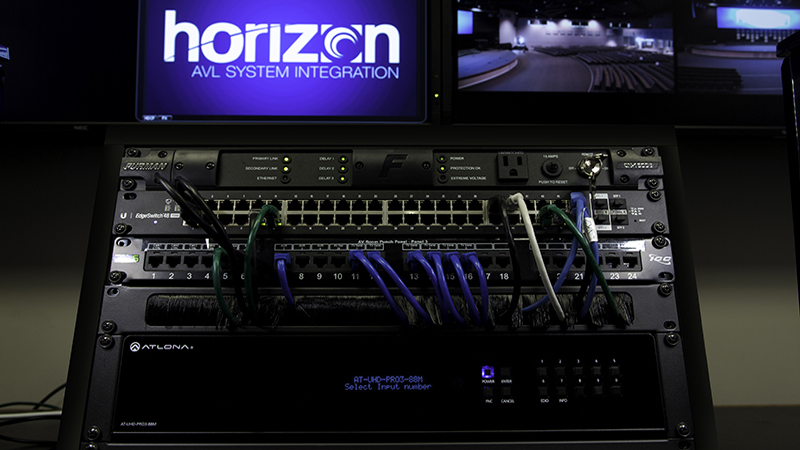
Case Study: Fellowship Alliance Chapel
A Church on the Rise
Download the Case Study PDFThe UHD-PRO3 is at the center of this 2,200-seat Fellowship Alliance Chapel for camera distribution to multiple displays and Internet broadcasts. System integration and design firm, Horizon AVL started from a clean sheet to ensure this Medford, NJ congregation can easily distribute current content standards while being ready for future video technologies.
There is something special about walking into a greenfield project as a systems integrator. With a completely fresh slate, there is a greater opportunity to bring an entire vision together and prepare the end user for future opportunities.
This was exactly the opportunity that Horizon AVL, a full-service systems design and integration firm, was provided when a longtime client, Fellowship Alliance Chapel, announced their relocation to a new ground-up facility in Medford, NJ. This gave Horizon AVL every opportunity to specify and install a system that would benefit Fellowship Alliance Chapel for years to come.
The initial goal was to build a venue with an audio, video and lighting system big enough to house live concerts and events in the main sanctuary, which seats 1700 on the floor and 500 in the balcony. As additions to the facility are expected – general plans have already been outlined for new rooms – there was also a desire to build an infrastructure that could scale to these spaces upon construction.
“The overarching trend in houses of worship is that churches are really looking forward now from a technology perspective, especially with things like LED wall technology, digital signage, audio networking and 4K video,” said Horizon AVL COO Joshua Kell. “This facility really captures all of that, and brings it together into a full system that saved us time and labor on the integration side, while giving the end user a strong foundation to build on for future AV opportunities.”
The Horizon AVL team interfaced with Holberg and Adison, the Medford-based architectural design firm, off the bat to ensure a smooth transition to the AVL integration phase.

“We looked at every aspect as the blueprints were drawn and the site was prepped for construction,” said Kell. “First and foremost, we paid special attention to the audio side, as we needed to eliminate the grounding, hum and other issues they were having in the old sanctuary. We quickly turned to video, with the goal of establishing reliable video distribution that would support HD, 4K and beyond.”
The specification called for network cabling to support all signal transport, which reduced costs and labor while providing plenty of headroom for future needs. Even in the present, the multitude of signals moving around the facility are impressive: In addition to switching camera signals, graphics and text to display screens from an Analog Way switcher, a headend with Atlona gear supports all video distribution around the building, a broadcast control room, children’s rooms, and common areas. When live services are dark, the Atlona system feeds digital signage content across most of these areas.
“Atlona gear supports all video distribution around the building, a broadcast control room, children’s rooms, and common areas.”
– Joshua Kell, Horizon AVL COO
“We went with shielded Cat6A for video because to achieve very long transport distances totaling several thousand feet, and we needed to futureproof beyond 1080p video,” said Kell. “Most of the building is prepped for 4K with that backbone in place.”
Brand New Sound
With Cat6 network cable also in place, the stage was set to quickly roll out a digital audio network. Horizon AVL almost immediately set its sights on a Dante network from Audinate, which was about two-thirds the costs of deploying a legacy system.
“One thing we focus on at Horizon AVL is remaining on the cutting edge of technology, as changes happen fast,” said Kell. “Dante is the most versatile option and the easiest to deploy; the total time to run cables, and configure the network and switches was well under a week.”
The overwhelming majority of audio signals and connections live on the Dante network, outside of a copper wiring run between a legacy stagebox and the front of house Allen & Heath S7000 mixer. From that mixer, the Dante network passes through an Allen & Heath DM64 digital signage processor and onto a Shure ULXD wireless microphone system.
Kell points to the simplicity of bringing the various microphones onto the network as a key example of Dante’s value from an integration standpoint.
“These are all wireless mics that we brought right onto the Dante network, without taking up any physical channels on the mixing rack,” said Kell. “The Allen & Heath system itself has several I/O slots, five of which we can utilize right now. With Dante, we only need to use one of those slots to achieve a 64×64 routing architecture – and we have maybe one-fifth of those channels spoken for. That is a lot of capacity for future needs.”
Beyond the microphones, the Dante network extends straight to the loudspeaker systems, which comprise steerable line arrays from PreSonus with integrated Dante-enabled amplifiers. This not only slims down the infrastructure, but keeps everything on the network through the end point.
“An Atlona AT-UHD-PRO3-88M acts as the matrix to distribute camera sources to the internet and eight NEC displays around the building.”
– Kell
“This is the first line array system to move beyond steerable FIR filtering for sound management,” said Kell. “PreSonus set the stage for this when they purchased Worx Audio a few years ago. We have all been in discussions about making Fellowship Alliance Chapel the model for this innovation. It is certainly the first house of worship to integrate a steerable line array with Dante capability in a single package.”
Kell adds that audio quality is a massive improvement compared to the old sanctuary.
“The labor and troubleshooting of adding transformers, isolating hum and managing ground noise all goes away in the digital realm, because phase grounding issues are eliminated all the way to the electrical panel,” he said. “The speech and overall intelligibility through to the steerable line arrays is top-notch – you can hear every syllable, every nuance in the vocals and every instrument, with the low latency that is important in live worship.”
An Engaging Vision
Horizon AVL’s Cat6A shielded backbone also laid the foundation for moving signals around the sanctuary from acquisition to projection. An Analog Way Ascender 32 4K switcher is used to switch Vaddio pan/tilt/zoom cameras and other source equipment. These signals are sent direct to a curved 68×13 LED video wall for live image magnification, and into the Atlona switching and distribution headend. An Atlona AT-UHD-PRO3-88M acts as the matrix to distribute camera sources to the internet and eight NEC displays around the building.
If the LED video wall dimensions seem unusual, they are. The wall was sized to meet the limitations of the available height, which included a big pallet that could be used for the curve. This strategy allowed the installers to take full advantage of the architecture from a height perspective, and limit the width to ensure the line arrays didn’t obscure anyone’s view.
As a result, the Horizon AVL team had to design a system that could support a 3744×832 pixel resolution.

“That’s an unusual resolution, and to scale to that size we are using Matrox TripleHead2Go systems to take two outputs from a Renewed Vision ProPresenter 6 system, which feeds the Ascender 32 4K switcher,” said Kell. “We’re also taking in the lyrics from another ProPresenter 6 feed and producing an overlay. We can basically take multiple inputs and layer them over each other, and then we use the Ascenderto produce a hard-edge blend of two outputs.”
The Ascender is a key element for addressing both the unusual HD resolution for the 68×13 wall, as well as standard 16×9 feeds. As camera shots change on the big screen, it produces the effect of appearing like two projector screens. However, it’s acting as one projection due to the multi-layer effect.
“Because we have multiple layers, the exact camera shot moving through the Ascender is output as a single camera feed to the building, with the lyrics and other elements on top,” said Kell. “The result is a multi-camera experience coming from one box.”
Making Connections
With so many video switching and distribution needs beyond the stage displays, Kell wanted a dedicated system to support a variety of formats and I/O connections.
“That is what particularly attracted me to Atlona,” said Kell. “They have a lot of different options to serve different capacity needs. The AT-UHD-PRO3-88M is one of their largest matrix switchers, and provides the team with the I/O capacity and distribution flexibility they need.”
At press time, the Fellowship Alliance Chapel team is using four inputs and four outputs, the latter of which distribute signals over the Cat6A backbone to eight compact Atlona AT-UHD-EX-100CE-RX and four AT-UHD-EX-70C-RX receivers. These receivers were selected as they could be hidden behind the displays, with an HDMI out feeding each display with live and digital signage content. The four inputs on the 8×8 matrix include the live building feed from the Ascender switcher for the camera shots and Renewed Vision feeds, as well as an Apple TV. The other two inputs feed digital signage content: When live sermons are not in progress, the Atlona system immediately switches to serve the digital signage. That content includes wayfinding maps and information on upcoming events in the various rooms.
Kell adds that all the Atlona gear is HDBaseT capable, which allowed his team to cleanly accommodate signal extension and audio/video control within the same system.
“Just as Dante changed audio, HDBaseT has been an important driving force when selecting displays, projectors, input and outputs,” said Kell. “It saves a tremendous amount of time and labor compared to dealing with fiber terminations, which kept us within budget on the video side.”
The Atlona headend resides in a tabletop rack in production control with the Vaddio camera controller and supporting video equipment. The Fellowship Alliance Chapel team has the flexibility to change inputs on the fly, and route video to different places. They can also turn the web interface on and off as needed, which helps them easily control what content they want to broadcast to internet viewers from the Atlona headend.
“What’s nice is that the video is being distributed through the service, and everyone knows where everything is headed at a moment’s notice from the stage to the pastor’s prep area,” he continued. “Atlona helps us reliably target all this content to very specific destinations.”
There is more to the video and audio infrastructure. An interesting example of where the two converge can be found in how the church uses Dante Via, Audinate’s computer-to-computer networking software
to move digital music around the facility. This includes a clean integration with Renewed Vision’s ProPresenter 6 software for audio track playout in alignment with video and lyric presentation.
“The depth of technology at Fellowship alliance Chapel is indeed too impressive to cover in the span of a single article,” concluded Kell.
| PRODUCTS FEATURED | PRODUCTS FEATURED |
| Model | Description |
| AT-UHD-PRO3-88M | Dual-distance 4K/UHD 8×8 HDMI to HDBaseT matrix switcher 4K/UHD @ 60 Hz video signals with Power over Ethernet |
| AT-UHD-EX-100CE-RX | 4K/UHD HDMI over 100M HDBaseT receiver for AV signals up to 330 feet |
| AT-UHD-EX-70C-RX | HDBaseT receiver for AV signals up to 230 feet |







